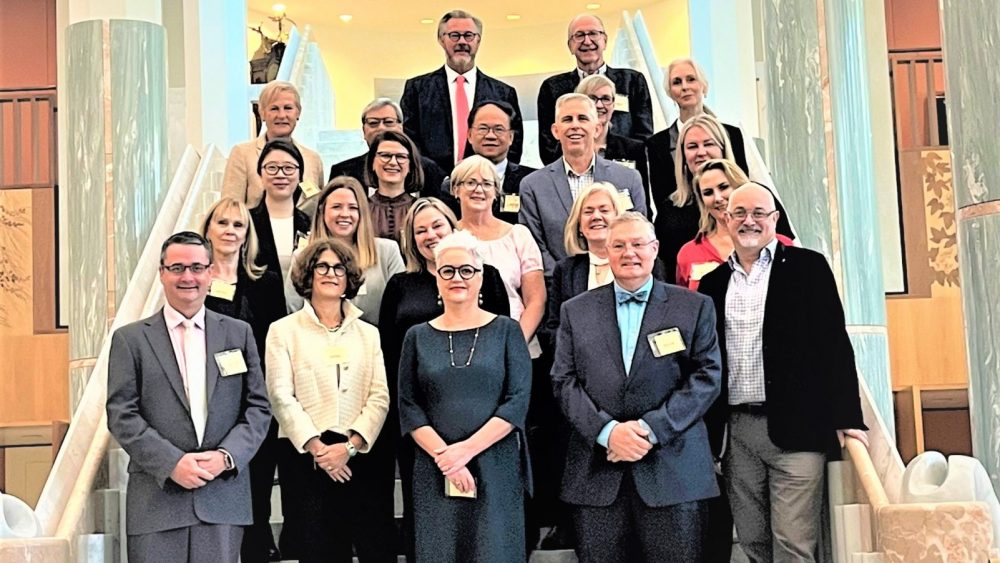Today marks the official launch of the ‘Integrative Oncology and Wellness Centres in Cancer Care’ white paper, by Hon. Ged Kearney MP, Assistant Minister for Health and Aged Care at Parliament House, Canberra. This inaugural white paper, funded by Dry July Foundation, validates the services of Integrative Oncology and Wellness Centres and provides a framework of recommendations to truly realise their potential.
At 25 years old, Bloomhill Cancer Care is the oldest community based integrative oncology centre in Australia and has assisted in developing this paper as part of the national wellness alliance, alongside Chris O’Brien Lifehouse, Peter MacCallum Cancer Centre, Solaris Cancer Care Foundation and NICM Health Research Institute at Western Sydney University.
Bloomhill Cancer Care CEO, Christopher John explained it is critical to shine a spotlight on these services and start a national conversation about the importance of Integrative Oncology and wellness in cancer care.
“Bloomhill is actually a unique service in Queensland assisting with the diagnosis, treatment and recovery from cancer or end-of-life through practical, emotional, physical and spiritual support for both the person diagnosed and their loved ones and carers,” said Mr John.
“More than 1,400 clients over the past year have accessed services directly from our wellness centre through our nursing wellness assessments and other services such as exercise physiology, counselling, acupuncture, art therapy, meditation or dietetics – something that many other communities only dream of.”
“We hear on a very regular basis that it is unusual to find other Queensland communities that have facilities or care services like ours and we have had several delegations visit Bloomhill so they can understand how they can develop this model of practice as well. To date Cairns, Toowoomba and Hervey bay have established similar style services on what they have witnessed at Bloomhill.”
The white paper was informed by an environmental scan commissioned by the National Integrative Oncology & Wellbeing Group and conducted by Deakin University supported by Dry July Foundation.
“Part of the alliance’s strategy to develop the paper is to influence and educate other communities about this model of operation, so that more people in Queensland and around Australia can benefit from integrative oncology when they have a cancer diagnosis,” said Mr John.
The burden of cancer is staggering.
- In 2021 there were at least 1.1 million people in Australia who were affected by or have been affected by cancer. By 2040, there will be 1.9 million[1]. This has major implications for the health system and economy.
- A large proportion (40%) of those cases are in people of working age (25-64 years old)[2].
- And new targeted treatment options and advanced interventions have led to more complex care needs in a growing cohort of people living longer with cancer.
“With cancer care in Australia changing at a fundamental level, this inaugural white paper validates the Integrative Oncology services that Bloomhill provides and delivers strategic recommendations to enable the sector to consider a consistent and coordinated approach, said Mr John.
“It is the goal to ensure these types of services fit with standard cancer care and can become accessible to all Australians.”
The white paper outlines the following six strategic recommendations:
- Develop guidelines for Integrative Oncology in Australia
- Identify and gain consensus on the critical success factors
- Prioritise routine collection of data
- Establish funding strategy
- Establish referral pathway
- Foster and progress a collaborative research program
Head of Supportive Care at Chris O’Brien Lifehouse, A/Prof Judith Lacey, explains “The reality in cancer care is that people affected by cancer and their families are not only looking for ways to live longer, but to live better with cancer.
“Around 1 in 2 people affected by cancer use complementary therapies to help them cope with the side effects of treatment and improve their long-term outcome, but this use is ad-hoc. With this comes safety risks and financial toxicity so it is time now to discuss how these services fit with standard cancer care,” said Dr Lacey.
“These therapies need to be provided by the right practitioners and at the right time to improve cancer outcomes, quality of life and to keep people thriving in their community and society.”
The white paper makes a valuable contribution to the critical consultation process ahead to make these services accessible while respecting the personal preferences, values, and culture of all Australians.
ENDS
Please note that Bloomhill Cancer Care CEO, Christopher John is available for interviews.
Link to the white paper:
https://cdn.me-qr.com/pdf/10485390.pdf
PR Contact: Fresh PR and Marketing, Helen Perry – Director, Email: helen@freshprm.com.au, Phone: 0431 065 964
[1] Council C. Australians living with and beyond cancer in 2040. Accessed 30 January 2022. https://www.cancer.org.au/assets/pdf/number-of-australians-living-with-or-beyond-cancer
[2] Bates N, Callander E, Lindsay D, Watt K. Labour force participation and the cost of lost productivity due to cancer in Australia. BMC Public Health. 2018/04/06 2018;18(1):375. doi:10.1186/s12889-018-5297-9



